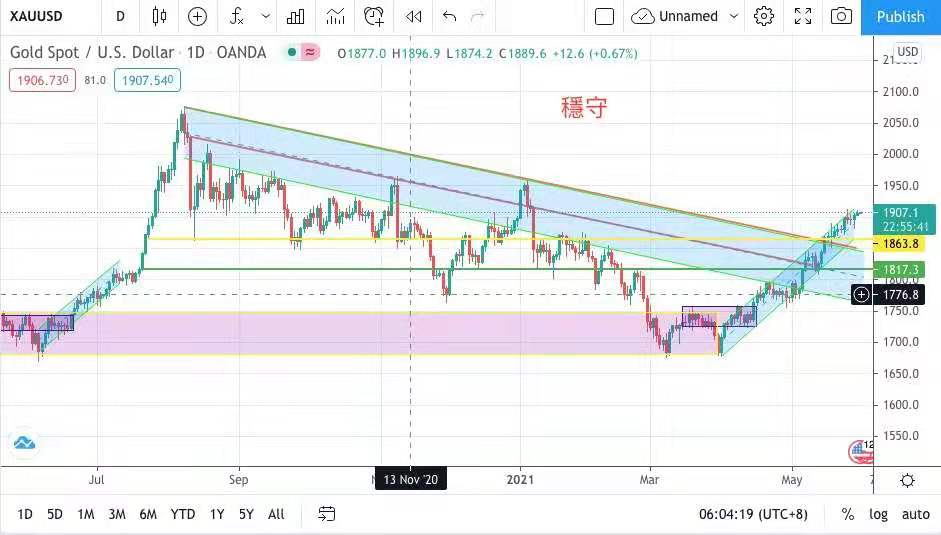Continue to talk about inflation
June 1 ST
Today's volatility range:
Yesterday, the US holiday was closed, and the performance of the gold market in Europe and Asia was relatively flat, with a high and low volatility of only 9 US dollars. From the monthly chart, the gold price has risen for two months and the weekly chart has risen for four weeks, and the market outlook continues to be optimistic.
Next target 1928/47. This week, there are non-agricultural data of the United States, and it is expected that the data will continue to be revised downwards. Whether we can use this data to provide better admission opportunities deserves our close attention.
Maintain yesterday's suggested volatility at 1888-1912, stabilize above 1912 is expected to challenge the 1920 mark.
Yesterday, the US holiday was closed, and the gold market was relatively flat in Europe and Asia. The high and low volatility was only US$ 9. The highest price of gold rose to US$ 1911, the lowest was US$ 1902, and closed at US$ 1906.
Stay firmly above the psychological barrier of $1,900, and rise by $3. Because the market has recently focused on the whereabouts and impact of inflation, and today is an American holiday, there is little data and there is no need to take into account the market.
Looking for an opportunity to talk about the topic of clearing accounts in the United States. Let's start with the last quantitative easing in the United States. In 2008, due to the problem of sub-borrowing bonds, the US investment bank with a history of more than 100 years
-Lehman Brothers was forced to declare bankruptcy, which also directly hit the confidence of the global financial industry. The so-called "financial tsunami" broke out, and banks were the mother of all industries. The US Federal Reserve first launched the whole period
A total of three rounds of quantitative easing program, so as to provide bank liquidity, and avoid shaking the foundation of banks. Shortly after the first round of quantitative easing, the central banks of Britain, Japan and the euro zone joined the banknote printing club one after another.
The quantitative easing program in the United States started in September 2008 and ended in October 2014, and the whole process lasted for six years.
With the help of the liquidity provided by the central bank, the economies of various countries have really stimulated. Let's use the well-known American Dow Jones index to explain it. Shortly after the financial tsunami began, the Dow Jones index was
In March 2009, the lowest point was 6470 points, which was close to 16,500 points at the end of the third round of quantitative easing, that is, when the market closed in April 2014, an increase of more than two times! And its rising trend can continue until before the global virus pandemic
Close to 28,000 points. Inflation was driven by quantitative easing, so gold also rose. The initial stage of quantitative easing was about 800 US dollars per ounce, and it climbed to the previous historical high in September 2011
$1921 per ounce, an increase of more than twice, but it only took a shorter time to get this effect! But when it comes, it goes quickly. Because of the global economic recovery, gold is doomed to be incomparable with other venture capital products.
Before the delisting of the United States, it fell first, and lived at $1,200-1,300 per ounce for a long time. To sum up, the new wave of Quankuan triggered by the COVID-19 epidemic has also been fermented, and the new york stock market and gold have peaked respectively.
If the Fed has a hand shadow of delisting in the future, we can learn from the past, and you should probably have a concept of how to operate it. If you are interested in getting more information, please use the hyperlink below this website to join the group for inquiry.
For detailed analysis and operational suggestions, please CLICK the following link to join the group and check with the administrator
https://t.me/mingtakchat
Previous Article Next Article


 Whatsapp
Whatsapp Telegram
Telegram
